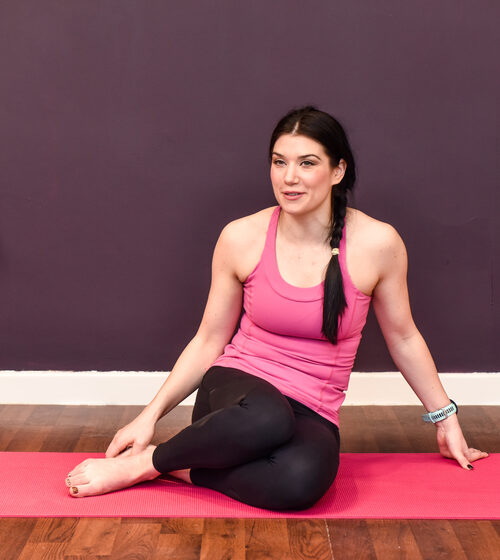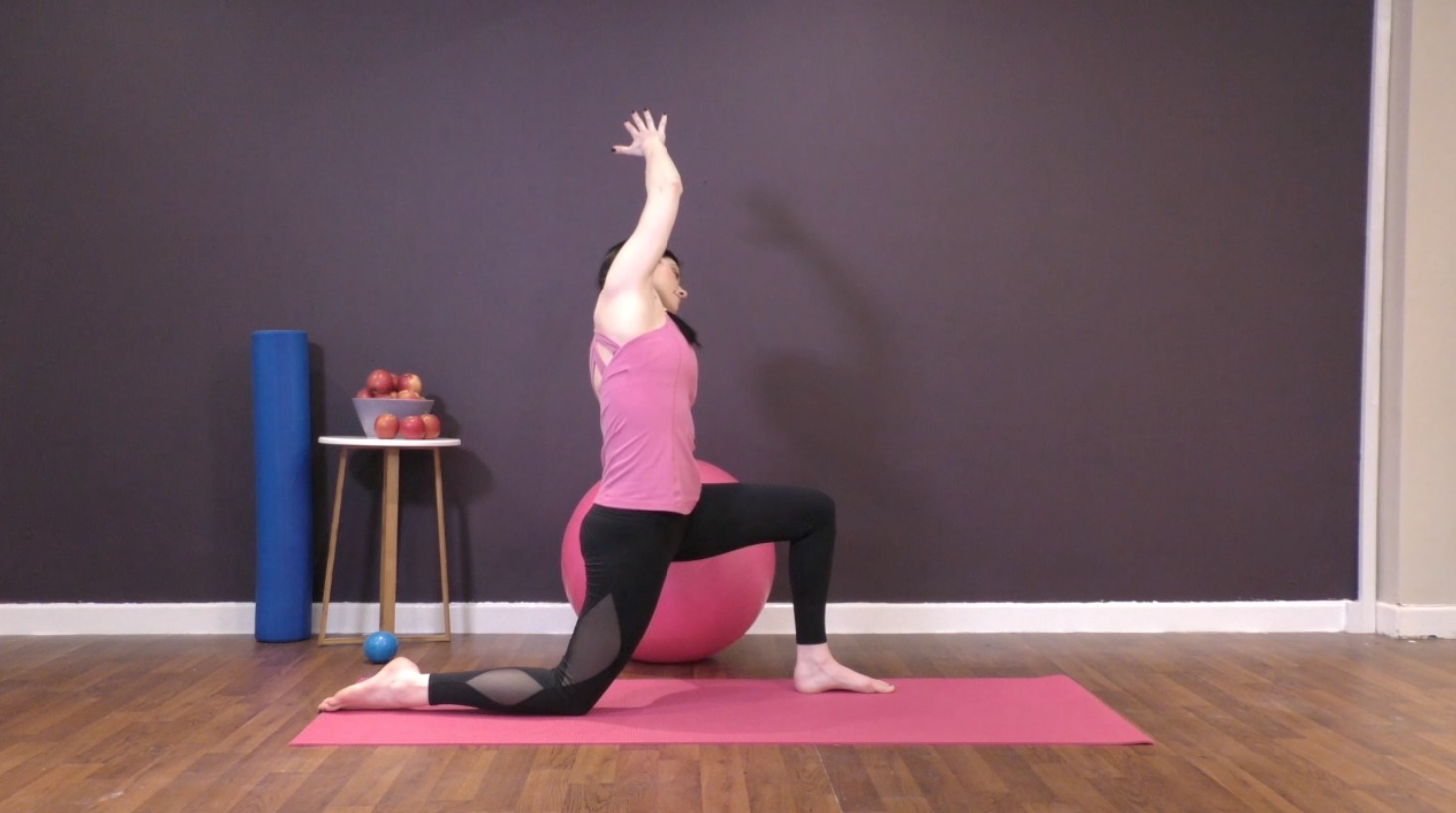
Core-Series 3
Series 3
Runner to the Core
The Pink Lady A Runner to the Core series has been specially designed by our Personal Trainer and Pilates expert Jane Linden to help runners, whether they are training for a marathon or simply jogging in the park. It's important to have good core strength before tackling these moves.
Read her blog for more information and inspiration.
- Plyometric Squat Jumps
- Multi-directional Lunges
- Side Plank
- Single-led dead lift
Stretching is an important part of any fitness routine and can be particularly beneficial for runners. It’s best to stretch warm muscles so make sure you include stretching as part of your post-run cool down. Whether or not you’re a runner stretching helps to improve your range of motion and increase muscle coordination.
- Hip flexor and quadriceps stretch
- Hamstring and ITB (Iliotibial Band) Stretch
Plyometric Squat Jumps
Following from our Pink Lady® Core Pilates series, we're launching our new A Runner To The Core series specially designed for runners.
Next up are Plyometric Squat Jumps which will allow for faster leg turnover and will enable you push off harder.
How to do a plyometric squat jump
Long distance running utilizes mainly slow-twitch muscle fibres, however when performing a plyometric exercise you also teach your body to utilize fast-twitch muscle fibres.
This will enable runners and athletes to maximize muscle recruitment, which will allow for faster leg turnover and will enable the runner to push off harder. This will increase running efficiency and lead to faster times.
Watch outs...
Land with bent knees
Ensure knees are in-line with toes
Keep chest lifted
Before starting our Runner To The Core series, you need to ensure you already have a strong core. Why not work your way through our Pink Lady® Core series?
Multidirectional Lunges
Following from our Pink Lady® Core Pilates series, we're launching our new A Runner To The Core series specially designed for runners.
Next up are Multi-directional Lunges which are a great way to challenge balance and dynamic flexibility.
How to do a multi-directional lunge
Lunges are a great way to challenge balance and dynamic flexibility. When performing a lunge the load distribution is emphasized on one leg rather than being equally spread between two legs as it is when performing a squat.
Multidirectional lunges challenge and improve dynamic stability in the torso and lower body, which directly relates to the sport of running helping to improve running stride.
Before starting our Runner To The Core series, you need to ensure you already have a strong core. Why not work your way through our Pink Lady® Core series?
Side Plank
This side plank is a great exercise to strengthen the core stabilizers (the muscles that keep the trunk stable during functional movement).
If you are a runner this exercise is especially good as it also helps to strengthen the hip muscles, which will support the hip and knee joints during running, when there is a greater demand placed on these muscle groups.
Watch outs..
Ensure the bottom hip doesn’t sink to the floor.
But before starting our Runner To The Core series, you need to ensure you already have a strong core. Why not work your way through our Pink Lady® Core series?
Single Leg Dead Lift
Just like running the single leg dead lift is an active hip extension and flexion exercise performed on a single leg.
It helps to strengthen all the muscles in the back body from the foot all the way up the back, including the shoulder blades when holding weights. These are the muscles that help to create a powerful run stride.
Watch outs..
Ensure shoulders stay back when performing the hip hinge
Keep hips square to the floor as you hinge forward
Keep good ankle, knee and hip alignment
Before starting our Runner To The Core series, you need to ensure you already have a strong core. Why not work your way through our Pink Lady® Core series?

Stretching is an important part of any fitness routine and can be particularly beneficial for runners. It’s best to stretch warm muscles so make sure you include stretching as part of your post-run cool down. Whether or not you’re a runner stretching helps to improve your range of motion and increase muscle coordination.
Hip Flexor + Quadriceps
Stretching is an important part of any fitness routine and can be particularly beneficial for runners. It’s best to stretch warm muscles so make sure you include stretching as part of your post-run cool down. Whether or not you’re a runner stretching helps to improve your range of motion and increase muscle coordination.
Hip Flexor & Quadriceps Stretch
Runners cannot avoid working their quadriceps and hip flexors (the muscles in front of the hips and thighs which you use every time you lift your knees), and so it is important to keep these muscles stretched and loose.
Kneel on the mat. Take a large stride forward with your left foot.
Keep your left knee above your left ankle and ensure your hips are square to the wall in front of you. Your right knee should be slightly behind your right hip. Tuck your tailbone under and track your left knee forwards so that you feel a stretch in the front of your right hip.
Rest your hands on your left knee and hold for 30 seconds and then come back slowly and repeat on the other leg.
If you have a large fit ball this exercise can be adapted to give a lovely side stretch at the same time.
Place the ball at the side of your left hip and place your left hand on the ball for balance (ensure the ball is always on the same side as your front leg). Reach your right arm up to the ceiling and take a side bend towards the ball to deepen the stretch in the right hip flexor.
Repeat on the other side.
Lying Hamstring + ITB Stretch
Stretching is an important part of any fitness routine and can be particularly beneficial for runners. It’s best to stretch warm muscles so make sure you include stretching as part of your post-run cool down. Whether or not you’re a runner stretching helps to improve your range of motion and increase muscle coordination.
Lying Hamstring & ITB (Iliotibial Band) Stretch
Runners often suffer from tight hamstrings that can cause lower back problems and lead to pulled muscles. Tight hamstrings also limit your range of motion, which has an impact on running stride, form and speed. To improve hamstring flexibility, try this lying hamstring stretch, which keeps the spine neutral where basic toe touches (forward bends) do not.
Lying Hamstring Stretch
Lie on your back with one leg bent and the other one straight – ankle knee and hip in line and no bend at the back of the knee.
Keep the leg straight, hold onto the back of your thigh and bring it closer to your body to increase your flexibility. Allow the muscles to get used to one position before you try to increase the stretch. Hold for about 30 seconds.
If you are unable to reach the back of your leg or foot, wrap a towel or scarf around your foot and pull the ends towards you.
Do not try to get your leg closer by bending your knee. This will not help to increase the flexibility of the part of the hamstrings we are trying to lengthen.
ITB (iliotibial band) Stretch
Keep the leg supported in the band, soften the knee to take the tension off your hamstring, and cross the leg over your midline. Ensure both sides of the pelvis stay equally weighted on the floor.
Once the leg has crossed your midline straighten your knee until you feel tension on the outside of your thigh or upper hip. Hold for about 15 seconds.
Repeat on the other side